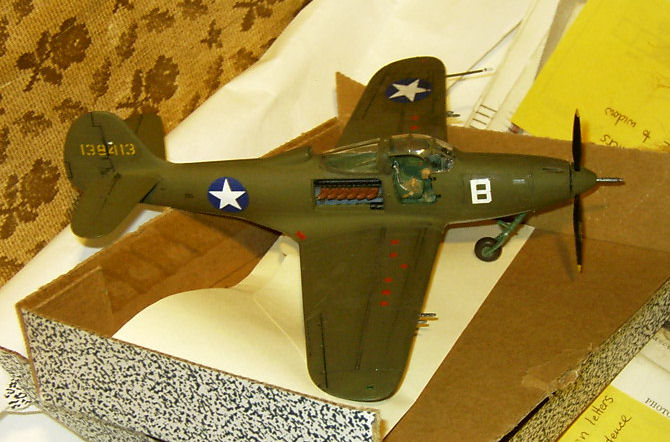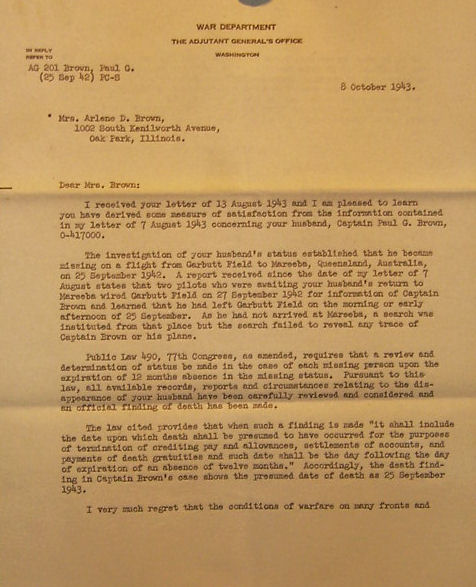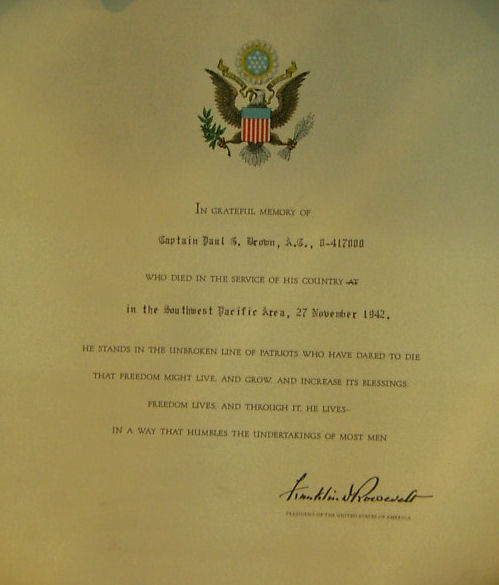25 SEPTEMBER 1942
CRASH OF A P-39 AIRACOBRA
FROM 36TH FIGHTER SQUADRON
8TH FIGHTER GROUP
BETWEEN TOWNSVILLE AND MAREEBA
![]()

Airacobra
A P-39D-1-BE Airacobra #41-38339 (c/n 14A-270) from the 36th Fighter Squadron of the 8th Fighter Group disappeared on a flight from Garbutt airfield to Mareeba on 25 September 1942. The P-39 was piloted by Captain Paul G. Brown (0-417000), who was a very well respected pilot from the 36th Fighter Squadronn. He claimed some of the Squadron's first victories in New Guinea. He had been due to stop at Mareeba but never arrived. Captain Paul Brown's eventual mission was to cover two schooners that left Wedau for GiliGili. Captain Paul Brown had been awarded the Silver Star, Distinguished Flying Cross, Air Medal with Oak Leaf Cluster. The American Battle Monuments Commission web site shows Captain Brown dying on 25 September 1942.
P-39 #41-38339 (Sumac SS Stephen Fields USAAF 15-Aug-42) had only just been assembled and air tested and was being delivered to the unit that was just replacing 76 Squadron RAAF at Milne Bay.
The following is from the History of the 36th Fighter Squadron:-
The first of the Cobras landed, after flight from Port Moresby, on the 24th. The balance of the ships remained at Moresby, with a few scattered at fields on the mainland. Captain Paul G. Brown was at Mareeba, Queensland, and he was reported missing after a flight from Townsville to Mareeba. He had remained behind on a special mission, and was to have rejoined the Squadron at Gili Gili. Mareeba is forty miles northwest of Cairns, a two hour flight for a cobra from Townsville. A direct route is over very wild, rugged country over virgin territory that is marked on the maps as unchartered. The air route, accepted as his line of flight, led along the coast. Captain Brown was marked as missing, after an intensive search had failed to locate any trace of his ship.
He possessed one of the most brilliant combat records of the Squadron. He had been on the first strafing mission over Lae, and had gained one probable Zero before his own gas tank was hit, forcing him down onto the beach. He returned to the Squadron after five days, and went back into action immediately. On May 8th he gained a second probable, shot down a Zero on the 13th, destroyed a fourth enemy ship by collision on the 14th before his luck ran low and he was forced to make a forced landing during combat on the 17th, after his ship had been seriously damaged. He sent a bomber down burning on the 18th of May to complete a record that was very great, made during eight combats. Like Captain Bevlock, he was awarded the Distinguished Flying Cross. Like Bevlock, he had been with the 36th Squadron since the early summer of 1941, and was regarded by the men and the officers as one of the veteran fighter pilots, - and ranked high with everyone as a man.
The late Bob Piper of Military Aviation Research Services in Canberra, told me that Brown had a mid-air collision with a Zero over Moresby on 14 May 1942. Brown's left wing carried away the top half of the Zero's rudder, and vertical fin and right elevator. Brown had been in a 250 mph dive. The Zero pilot has been identified as Petty Officer 1st Class Tooru Oshima. The wreckage of his fighter was later examined 25 miles north of Port Moresby. Brown later needed two feet replacing on his left wingtip.
Craig Grude's mother who had been married to Paul Brown at the time of his tragic disappearance, mentioned the incident of the above mid-air collision victory many times when Paul was growing up. She also mentioned an incident where Paul Brown exploded a "Betty" with a full bomb load that started a chain reaction of explosions in a "Betty" V formation that took down several of the other bombers. Paul has also read of this exploit in a copy of "The Bell Ringer" which was a company magazine for the Bell Aircraft Corporation. Paul has never been successful in finding a source for these magazines and Bell Corporation did not keep a library of them. Does anyone have copies?
On 2 June 2009, Craig Grude sent me the following summary of events surrounding the loss of Captain Paul G. Brown (0-417000):-
I wanted to pass on this information I was able to obtain. It clarifies mush of the story of Paul Brown's last flight. In August of 2008 Bob Piper gave me a suggestion for a source I had known about through the U.S. Army Total Personnel Command. I made an inquiry and received a package from a Thomas M. Jones, the Chief of the Freedom of Information Office. Included was both a copy of the "Report of Death" investigation, summary of court-martial to the Army Effects Bureau and the Missing Air Crew Report (MACR # 16234.) There were also copies of personnel letters between the War Department and both my mother and Paul Brown's Father that were very interesting.
The gist of my original story appears to be mostly correct. On 23 September 1942 Capt Brown left Ross River Air Field, Townsville, Queensland with 21 other P-39D-1s of the 36th FS en route to Milne Bay, New Guinea. There was a planned re-fueling stop at Coen, Queensland, then a planned stop at Port Moresby, New Guinea before arriving at Milne Bay.
En route to Coen two aircraft developed engine problems. One flown by a Capt. John Thogerson the other by LT. Tom Cox. They both safely landed at Mareeba accompanied by Paul Brown. The idea was that Paul Brown could expedite repairs and since neither of these other pilots was familiar with the area then lead them on to Milne Bay.
After several flights back and forth between Ross River and Mareeba Paul Brown was on a return flight to Mareeba when he was lost. The report reflects the conclusion that Paul Brown was on a return flight to Mareeba was drawn by the fact that the next day a B-17 arrived at Mareeba with a battery for one P-39 and a front tire for the other to complete repairs.
It also appears that these flights were an hour in duration as it is listed that he left APO 920 at 0700 hours and landed at APO 922 at 0800 hours. He then left APO 922 at 0900 hours with an expected arrival time of 1000 on 25 September 1942 back at APO 920 which never occurred. The way the rest of the report reads it appears APO 920 is Mareeba and APO 922 is Ross River.
The weather appears to have been a probable factor in this incident. A front was reported moving in from the west at approximately 0945 hours this day which brought the ceiling down to 3,000 feet. At around 1700 hours that day rain came into the area. A statement from Capt. John Thogerson indicates that on the morning 27 September 1942 they had still not heard from Paul Brown and wired Townsville about his status and were informed Paul Brown had left Townsville around 1300 hours on the 25th.
A Colonel Carmichael, CO of the 19th Bomber Command put up a B-17 with Thogerson and Cox to conduct a search of the area with negative results. Another point of interest was that Paul Brown's missing status went unnoticed because of a change of command at Mareeba the day of this incident.
The report also documents that Paul Brown liked to use the coast for this route instead of heading overland. He was aware of and had used an emergency landing field on an island off Innisfail, Queensland and another at Cairns, 30 miles east of Mareeba. Paul Brown had also instructed other pilots that a wheels up landing could be made on several different locations of beach along this coastal route.

Photo:- Craig Grude
A model of a P-39 Airacobra held my Captain
Brown's wife.
The tail No on this model P-39 Airacobra is 41-38413

Scan:- from Craig Grude
Letter from the War department to Mrs. Arlene D. Brown

Scan:- from Craig Grude
Memorial Certificate from President Roosevelt
Subject: Here's My Story
Date:
Sat, 24 Apr 1999
00:25:40 -0500
From: Craig Grude
cng-slg-022578@sbcglobal.net
My name is Craig Grude. I'm from Chicago, Illinois. My father was in the 44th Depot Repair Squadron that was stationed for a time near Brisbane, and took liberty there. He spent most of his time in an area of New Guinea called Finchaven. My mother, who passed away this last Christmas, was a war widow. Her husband's name was Lt. Paul G. Brown of the 36th Fighter Squadron, 8th Fighter Group. I have been doing some research on him because of a story my mother always told. He and his wingman were on a mission. The wingman was forced down on some island and Paul landed to check on him. They found mechanical problems with his plane, a P-39 Airacobra and Paul made several runs back to the base to obtain parts. Paul took off after they repaired the plane and when the wingman returned, Paul had not. He was never heard from again.
I have been able to obtain from the USAF archives, that Capt. Paul Brown left on a sortie from Garbutt Field on 28 September 1942, to cover two schooners leaving Wedau for Gili Gili via the East Cape. He was never heard from again and listed as MIA. No record of a Missing Air Crew Report (MACR) was located in the archives.
Paul Brown and my mother were both from a suburb of Chicago and Paul was from a prominent family of that suburb, Oak Park. When he was reported MIA, it was picked up by a number of Chicago Newspapers. My father received one of those papers. the Chicago Herald-Tribune, during the war at his base in Finchaven. Along with the article was a picture of my mother. When my father read the article he announced to several members of his unit that he was going back to Chicago and marrying that girl. They met at a USO dance in late 1945 and were married on 1 September 1946.
That's my story. I'm looking for any and all information I can obtain on Paul, his missing plane or anything else that can get me a handle on his story and possible resting place. Thanks for taking the time to read this.
Craig
![]()
Subject: Re: Here's My Story
Date:
Sun, 25 Apr 1999
02:17:06 -0500
From: Craig Grude
cng-slg-022578@sbcglobal.net
I don't know the name of the island that the wingman landed on, for that matter I can't find out the name of the wingman. I've been attempting to find a group that does a reunion for this squadron, but have not been successful. The only 36th fighter squadron reunion I can find is from a unit that was/is stationed in Korea. I'm going to keep looking. If you find anything, please send it my way.
During my search I did find a guy that served with my Dad in World War II in New Guinea and the Philippines, and we have been sending notes back and forth on the NET ever since. By the way, my father's unit assembled aircraft as they were shipped from the States into the Pacific Theater. He worked on P-47's, A20's, B-25's, but mostly P38's. His unit assembled the first 1,000 P38's in the Pacific Theater. I have a picture of him and his unit standing on it in Finchaven, New Guinea. Possibly the one that crashed near Townsville was one of them.
Well, in my best Chicago accent, "Chubetcha, tanks a bunch...lader." Translated its, You bet you, thanks a lot, see you later. By the way, if you ever get to watch a TV program called NYPD Blue, the actor Dennis Franz grew up very near to my neighbourhood and his accent is not from New York, it is pure Chicago. Another TV oops.
Craig
ACKNOWLEDGEMENTS
I'd like to thank Bob Piper, Craig Grude and Gordon Birkett for their assistance with this web page.
Was Captain Paul Brown's Airacobra ever found?
Can anyone help me with more information on this crash?
"Australia @ War" WWII Research Products
|
© Peter Dunn 2015 |
Please
e-mail me |
This page first produced 26 April 1999
This page last updated 27 May 2020